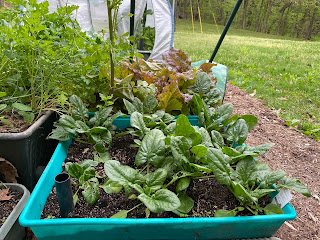There are hundreds of tomatoes to choose from. There are whole catalogues devoted just to America’s favorite home garden vegetable. There really is nothing like a homegrown tomato, fresh off the vine! With so many to choose from, how do you decide which is best for your garden?
Some consideration for deciding what to plant-space you have, flavor, how you use tomatoes, and which types grow best and give the biggest yields in your area. Ask your neighbors or farmers market sellers which types they have found grow the best for them. For heirloom and open pollinated types you buy from the farmers market, save the seeds from the ones you like and you can grow them in your garden!
I prefer heirloom and open pollinated, organic veggies. I love the idea of seeds being handed down from generation to generation with loving care, through good times and bad. Back in the day, every vegetable and vegetable seed was precious. You should save the seeds from your very best tasting, performing plant with the biggest fruits. It was a sacrifice to take the biggest, juiciest fruit for its seeds. Seeds were like gold back then.
Today, we save seeds from the best performers in our garden so year after year our veggies are better adapted to our specific garden conditions and tastes. Seed saving-fun, easy and a cost saver
 |
| Chocolate cherry tomatoes |
Family lore has it that my great grandfather killed a man in self defense when one of my great uncles stole some seeds the neighbor had ordered. The neighbor came with a gun and confronted my great grandfather for the theft of his seeds. The family had to leave the state, worried that the law would come after him. At least, that is a story I heard told.........
This year I have told myself I am going to stick with 3 tomato plants. 2 for canning and salads and one for slicing tomatoes. I say that every year and usually end up with at least 5 because I see ones I just can't resist.
You may be surprised with my canning tomato choices. I can all types of tomatoes. I plant tomatoes that give lots with great taste and preserve all that we can't eat. I have recently been growing the darker tomatoes since they are so healthy! For more on the benefits of darker veggies, The Power of Purple If you are curious on how the color of tomatoes affect its health benefits,
Different colors in tomatoes give different nutrition or just a ranking on overall health benefits by type,
Most nutritious heirloom tomatoes They even have tomatoes today that are bred specifically to increase the healthiness of the tomato!
I get the best yields from the smaller tomatoes. In the past, I used to get loads of tomatoes with Juliet (a hybrid, 1999 All American) and Yellow Pear (a heirloom from pre-1800). Both are indeterminate, meaning they produce from summer through frost. The Juliet is a mini Roma, great taste. The last couple of years, the Juliet and pear tomatoes have not been doing well in our garden. Small tomatoes Sun Chocolate, Indigo Rose, and Baby Boomer all did well in our garden last season.
The smaller tomatoes are great for drying as well. I like using my electric dehydrator for "sun dried" tomatoes as it is usually just too humid in the Midwest to dry tomatoes in the sun.
 |
| Large heirloom Italian Red Pear tomato, good for sauce and slicing |
For slicers, the heirloom Brandywine, dates back to 1885, is a taste favorite which we have grown many times. It continues to win taste tests to this day. I tried a grafted tomato from Territorial Seed Co. and it did very well. A graft is an age-old technique of taking a strong root stock and grafting a tasty plant on to it. Lately, we have been trying different chocolate varieties, an early variety and a winter storage variety. Cherokee Purple slicer, Glacier for early tomatoes, and Red October as a storage tomato we have good luck with in our garden.
One large tomato variety that has done surprising well over the last couple of years is Italian Red Pear. It is a large heirloom paste tomato traditionally used for canning. It does great all the way through late fall. I am definitely growing it again this year. It makes silky smooth tomato sauce and soups. I saved the seeds from an heirloom tomato I bought at Whole Foods. Any time you purchase an heirloom veggie, you can always save the seed and grow them in your own garden.
Just as a note, hybrids will not come back like its parent. Be sure to save seed from heirloom or open pollinated types to be sure you will get what you expect. Or if you like surprises, feel free to plant the seed and see what happens! What do the terms GMO, natural, heirloom, organic, hybrid really mean?
If you are short on space, there are many dwarf and patio varieties that can even be grown in pots! We have had good luck with Bush Early Girl (only 54 days ‘till ripe tomatoes), Patio, Husky Red, and heirlooms Lizzano and Tumbling Tom. There are many more options!
Compact tomatoes for small spaces and pots |
| Yellow Tumbling Tom, a dwarf variety |
Just three tomato plants should give us (a family of 2) enough for eating, freezing for salsa, and canning that will last us until the next year. You don't need many plants to get a whole lot of fruits!
For more on growing tomatoes, these blogs can help you get started growing your own tomatoes this season:






